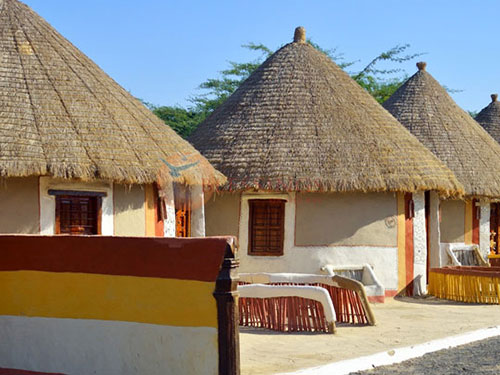

Gujarat Tourism has one of the finest tourist attractions known as Kutch Tourism. Kutch tourism offers you White Rann, Rann of kutch Festival known as Rann Utsav, Mandvi Beach, Black Hill, Kutch Fossil, Dholavira and many more. Some wonders of Kutch will amaze you during your Kutch Tour.

Bhunga of Kutch (A circular hut from Kutch, Gujarat). Bhunga is a type of hut from dessert area of Gujarat, Kutch. It is earthquake proof design made out of Mud blocks, Mud plastering and mud flooring.
Bhungas are traditional houses unique to the Kutch region in Gujarat. The houses are circular walled with thatched roof. They are known for their structural stability in earthquakes and for being climate responsive. It also protects against sandstorms and cyclonic winds.
It is constructed using locally available materials like clay, bamboo, timber, etc. Structurally the roof is placed on two thick wooden posts placed across the circular walls. These two posts bear the weight of the roof. Wooden framed windows are set at a lower level for cross ventilation. The low hanging roofs cover the walls against direct sunlight and add to the insulation from the environment. The thatched roof is built on top of the walls resting on a spiral frame forming a cone.
The traditional bhunga requires periodic maintenance, a regular application of lipai or lime plastering to the walls and floor, and the replacement of the dried grass on the roof. The exterior walls are adorned with colourful paintings while the interiors are decorated with exquisite mud and mirror work.
The main peculiarity of Bhunga is its design. Generally ordinary houses are of square or rectangular shape, instead of that Bhunga houses are of round shape. At the time of earthquake it was noted that when skyscrapers made of cement and steel felled like a pack of cards, Bhungas stood strong due to its composition and size. Thus Bhungas are very popular due to their unique make. Bhungas are made of different materials like was there are different types also. Generally in tradition Bhunga babool wood, grass is used as a structure and earth/cow dung is used for plastering and flooring.
The roof is made of wooden top dome where bamboo sticks are tied together with a dried grass rope which weaved with thick layer of grass is then placed on the roof and securely tied down. The walls are made of bamboos sticks with a layer of grass tied to it. Mud and cow dung are used as wall plaster over the grass. They are single cylindrical structures put close to each other to form a house. In common terminology, each bhunga would be equivalent to a room in a house. Bhungas are mainly found in desert islands in the northern parts of Kutch region of Gujarat- specially Banni and Pachham. Banni and Pachchham, Kutch
Get An Experience Worth a Lifetime Book Now